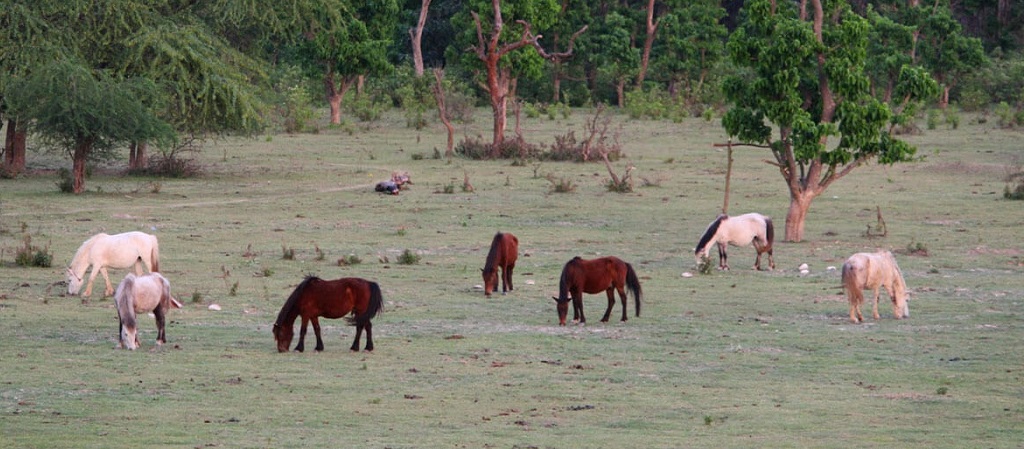Devbhoomi Uttarakhand - full of lush green valleys and natural wealth has been a centre of attraction for centuries and Rajaji National Park is situated like a Kohinoor diamond in the crown of this Devbhoomi. Rajaji National Park is located in the picturesque lap of nature and one of the best natural habitats of giant Asian elephants. Being located in the Shivalik Terai in the foothills of the Himalayas, there is an amazing diversity in the natural environment of this park and the species and types of wild animals living in it.
Rajaji National Park is a unique confluence of botanical and landscape diversity of the Himalayan and Gangetic plains. This national park is named after Chakravarti Rajagopalachari popularly known as 'CR' or 'Rajaji'. Lawyer, writer, politician and philosopher Rajagopalachari was the second Governor General of independent India and the first Indian Governor General. He was the Chief Minister of Madras province from 10 April 1952 to 13 April 1954. He was Gandhiji's samdhi (Rajaji's daughter Lakshmi was married to Gandhiji's youngest son Devdas Gandhi). He worked a lot for the promotion of Hindi in South India.
Really it is Paradise for Nature Lovers
The dense green landscape adorned with forested hills, the gushing waterfalls in the valleys and the amazing variety of wild animals have made this Rajaji National Park a favourite paradise of nature lovers and those who love wildlife.
This park spread over 820-42 square kilometre was established on 17 August 1983 by combining three sanctuaries named Rajaji (established 1948), Motichur (established 1936) and Chilla (established 1977) and was named 'Rajaji National Park' after Bharat Ratna Chakravarti Rajagopalachari. Generally, there is a rare silence and peace spread in it which is sometimes broken by the alarm sound made by deers on getting a glimpse of elephants, leopard, tiger or leopard or by the chirping of birds. Every tourist who spends some time in this peaceful lap of nature feels spiritually enriched on return.
An Abode of More than 500 Elephants
This is also the core area of the 'Shivalik Elephant Reserve' identified under 'Project Element'. Here about 500 elephants live in their natural form. Often large herds of elephants are seen roaming here. Sometimes the sudden encounter of tourists with the giant elephant can become an unbelievable event. The ratio of male-female elephants here is also better than other areas inhabited by this species. This park marks the north-western boundary of the natural habitat of tigers and elephants within the Indian subcontinent.
Huge Diversity of Animals
Spread between 300 and 1350 meters above sea level, this park is important both in terms of the number of its tribal wildlife and species diversity. It is also an important habitat for some endangered species like tiger, leopard, ghoral and mahseer. In this park, ghoral can be seen running easily on a difficult slope, which can be a memorable experience for the tourists.
• Asian Elephant: Rajaji is one of the significant habitats for the Asian elephant in northern India.
• Tiger: The Park is part of the larger Shivalik Elephant Reserve and also supports a population of Bengal tigers.
• Leopard: Commonly spotted throughout the park.
• Goral (Mountain Goat): Found in the hilly regions of the park.
• Himalayan Black Bear: Inhabits the higher altitudes.
• Sloth Bear: Often seen in the lower regions.
• Deer Species: Including sambar, chital (spotted deer), and barking deer.
• Wild Boar: Commonly found in the park.
• Rhesus Macaque and Langur: Two species of primates found here.
• Great Hornbill: A prominent and colorful bird.
• Pied Hornbill: Another species of hornbill found in the park.
• Kingfishers: Various species including the Common Kingfisher and Pied Kingfisher.
• Woodpeckers: Different species such as the Lesser Golden-backed Woodpecker.
• Peafowl: Commonly seen throughout the park.
• Eagles and Hawks: Including species like the Crested Serpent Eagle and Changeable Hawk-Eagle.
Three Species of Deer is Found
Three species of deer, Chital, Sambhar and Kakar as well as Himalayan bear, Indian bear, otter etc. are also found here. King Cobra is the special resident of this park. There are more than 300 species of birds in this park, out of which more than 90 are non-migratory. In winter, various migratory birds are easily seen roaming from Rishikesh Barrage to Bhimgoda Haridwar. Every tourist who spends some time in the peaceful lap of nature at Rajaji National Park feels spiritually enriched on return. Rajaji National Park is located near Dehradun, the capital of Uttarakhand. It is also close to the religious cities Haridwar and Rishikesh. Due to rich biodiversity and natural beauty and nearby cities, Rajaji National Park has a special place in the tourism map of Uttarakhand.
Rajaji National Park is open for tourists from 15 November to 15 June every year. The 9 forest rest houses located at various attractive places inside the national park are almost a century old which welcome all the visitors with a lifelong memorable wildlife viewing experience. Reservation of forest rest houses can be done one month in advance. To visit Rajaji National Park, it is necessary to obtain a permit from the entrance gate and to get a no dues certificate before returning. Going to the core area of the national park and use of loudspeakers is prohibited.


